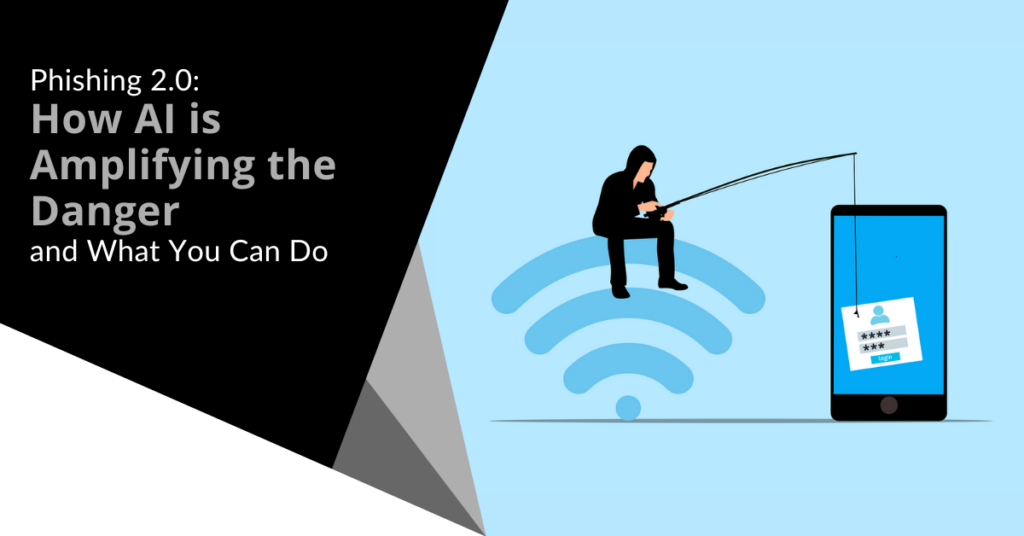|
Getting your Trinity Audio player ready...
|

Phishing has long been a significant threat, but with the rise of AI, it’s now more dangerous than ever. Phishing 2.0 has arrived, and it’s smarter, more convincing, and much harder to detect. Understanding this evolving threat is essential for everyone.
Recent data shows a staggering 60% surge in AI-powered phishing attempts. This alarming statistic serves as a wake-up call: phishing is only becoming more sophisticated. Here’s how AI is intensifying phishing attacks and what you can do to defend yourself.
The Evolution of Phishing
This method of attack started off simply—hackers sent mass emails, hoping a few recipients would take the bait. Early phishing emails were often poorly written, filled with grammatical errors, and easily spotted by cautious users.
Fast forward to today, and things have evolved. Attackers now leverage AI to fine-tune their tactics. With AI, they craft highly convincing messages and personalize attacks, making phishing more effective than ever before.
How AI Makes It More Dangerous
Crafting Authentic Messages
AI’s ability to process and analyze massive amounts of data enables it to replicate how people write and communicate. This allows attackers to generate messages that closely resemble authentic emails. These messages can easily imitate the tone and style of legitimate correspondence, making them difficult to identify as fraudulent.
Personalized Attempts
AI also mines social media and other public sources of information to personalize phishing messages. These emails may mention your job, hobbies, or recent activities, making them feel legitimate and increasing the likelihood you’ll fall for the scam.
Spear Phishing Tactics
Spear phishing focuses on targeting specific individuals or organizations. It’s a more advanced form of phishing, and AI amplifies its effectiveness by allowing attackers to conduct deep research on their targets. Tailored messages are crafted to appear genuine, making them particularly hard to distinguish from real communications.
Automated Campaigns
AI can automate the process of sending out thousands of messages at once. It can also adapt based on responses. For example, if a recipient clicks a link but doesn’t enter information, AI can trigger follow-up emails, increasing the chances of success.
Exploiting Deepfake Technology
Deepfakes utilize AI to create hyper-realistic fake videos and audio. Cybercriminals can now produce fake videos of CEOs or other authority figures to trick employees into divulging sensitive information. This advanced form of deception adds another layer of danger to phishing attempts.
The Impact of AI-Powered Phishing
Increased Success Rates
The sophistication of AI makes phishing attacks more effective. As more people fall for these AI-enhanced schemes, the number of data breaches rises. Companies experience financial losses, while individuals may face identity theft and other personal crises.
Harder to Detect
AI-enhanced phishing attacks are increasingly difficult to catch using traditional detection methods. Spam filters may miss these cleverly crafted emails, and employees may not recognize them as fraudulent. This allows attackers to infiltrate networks with greater ease.
Greater Potential for Harm
Personalized and highly convincing AI-driven phishing attacks can lead to more severe data breaches. Cybercriminals can access sensitive information or disrupt operations, causing significant financial and reputational damage to businesses.
Protecting Yourself from AI-Driven Phishing
Maintain a Healthy Skepticism
Be cautious of unsolicited emails, even if they appear to be from a trusted source. Always verify the sender’s identity and avoid clicking links or downloading attachments from unknown sources.
Watch for Warning Signs
Look out for signs of phishing, such as generic greetings, urgent language, or requests for sensitive data. If an email seems too good to be true, it likely is.
Implement Multi-Factor Authentication (MFA)
MFA provides an extra layer of security. Even if someone steals your password, they’ll need another form of verification to access your account, making it harder for attackers to succeed.
Stay Informed and Educate Others
Education is one of the best defenses. Stay up to date on the latest phishing tactics and share this knowledge with others. Training helps people recognize and avoid phishing attempts.
Verify Sensitive Information Requests
Never provide sensitive information via email. If you receive a request, confirm it through a different channel, such as a phone call to a known number.
Invest in Advanced Security Solutions
Security software designed to detect and block phishing attempts can be an invaluable tool. Ensure your email filters are set up to catch suspicious messages, and keep all security software up to date.
Report Incidents
If you encounter a phishing attempt, report it to your IT department or email provider. Reporting helps improve security measures and protects others from falling victim to similar attacks.
Enable Email Authentication Protocols
Use email authentication methods such as SPF, DKIM, and DMARC to protect against email spoofing. Enabling these protocols for your domain adds an extra layer of security to your communications.
Conduct Regular Security Audits
Routine security audits help identify potential vulnerabilities in your system. By addressing these weaknesses, you can reduce the risk of successful attacks.
Need Assistance?
The threat of phishing 2.0, amplified by AI, is real and growing. These attacks are more convincing and challenging to detect than ever before. Is your email security up to par? It may be time to evaluate your defenses.
Reach out to us today for a comprehensive review of your phishing protection measures.
Twintel has grown into an expansive, full team of IT services professionals, acting as the outsourced IT department of non-profits, small to mid-size businesses, and enterprise-level corporations in Orange County, across California, and nationally.
Today, it’s the strength and deep expertise of the Twintel team that drives positive outcomes for clients. Each of the support staff, technicians, and engineers works diligently each day to make sure that the companies served have the seamless, secure, and stable IT environments needed to allow them to pursue their organizational objectives.